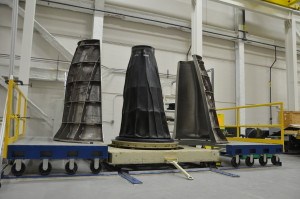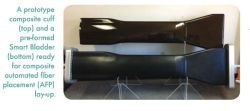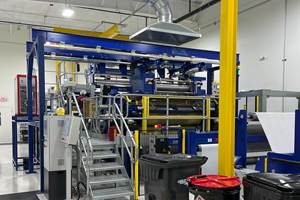Inflexion technology: complex composites without fasteners
Spirit AeroSystems has developed production methods using rigid-flexible tooling for more affordable unitized composite aerostructures.

Spirit AeroSystems’ Inflexion technology enables manufacture of large, complex composite aerostructures in one continuous piece that are lighter, more affordable and more efficient.
SOURCE: Spirit AeroSystems
In 2013, Spirit AeroSystems (Wichita, KS, US) announced that it was working with Spintech (Xenia, OH, US) to develop new tooling technology for manufacturing complex composite aircraft structures. Trademarked as Inflexion, the technology is based on re-formable, reusable mandrels, and touted as enabling integrated composite structures with features not possible to achieve using traditional tooling.
Traditional composite structures manufacturing uses rigid tooling that must be removed from inside the part. But this limits the size and complexity of structures. Inflexion tooling can be transitioned between rigid and flexible states for easy removal, regardless of part size and complex geometries. As explained by Spintech engineering director Tom Margraf in a 2013 interview:
“The composites manufactured using Inflexion are structures that integrate engineering stiffeners such as frames, stringers, spars, and longerons with skin panels that are co-cured in a single cure process. The inflexion process eliminates the need for secondary bonding and/or fastening of engineering stiffeners, which enables lower cost, lighter weight, and more damage tolerant structures.”
Years in the Making
Spirit AeroSystems began working on Inflexion in 2005, collaborating with Cornerstone Research Group (CRG, Dayton, OH, US), which had developed tooling using its patented shape memory polymer (SMP) materials. CRG spun off Spintech Ventures LLC in 2010 to refine the technology and scale it up for industrial aerostructures production. Spintech offers the technology under the trade name Smart Tooling (follow the link to see videos of how the technology works). Spirit’s version reportedly includes enhancements it has developed for producing large, integrated structures with singled-sided reinforcements (e.g., stiffeners).


Spirit's Inflexion technology is based on Smart Tooling which uses
shape memory polymer (SMP) materials to enable rigid layup tools
that become elastomeric after cure for easy extraction.
SOURCE: Cornerstone Research Group (CRG) and Spintech/Smart Tooling.
CRG completed a Phase II Small Business Innovation Research (SBIR) project with NAVAIR, demonstrating Smart Tooling’s benefits. During the 2011 Navy Opportunity Forum, Spintech summarized these as including increased throughput, which reduces total process time; increased repeatability from part to part due to a rigid, net-shaped, layup tool; and up to an 80% reduction in manufacturing cost.
"Smart Tooling's patented technology allows composite manufacturers to significantly reduce a combination of labor, material, and capital cost, while significantly increasing production throughput of composite parts with trapped features and/or complex shapes," said previous Spintech president Craig Jennings.
According to a 2013 press release, Spirit Aerosystems acting director of technology Bill Smith explained that Inflexion allows “extraction of the tool in spite of trapping features which would hinder current tooling methods. This enables, for example, the full integration of skins, stringers, and frames or ribs in one step."
Investment for Future Contracts
In the 2013 The Wichita Eagle article “Spirit’s ShadowWorks, a technology investment,” author Molly McMillin asserts that Spirit AeroSystems’ investment into innovative technologies like Inflexion is aimed at helping the company win new programs and retain customers. Quoting Spirit research and development engineer Allison Wright, Madison writes that Spirit “looks to provide customers the capabilities they need in their products — lower weight, more efficiency or better manufacturing processes.” She notes that cost is also key as Spirit competes with other large firms for contracts from aerospace OEMs.
This article too quoted Spirit’s technology/R&D director Bill Smith: “It’s not about putting in ‘gee whiz’ technology for the sake of technology. It’s for the requirements and capabilities that an airplane needs. ... It’s about, ‘Can you offer more cost-effective solutions than your competitors?’ ” He pointed out that there are consequences to missing out on new programs. “If you lose one, you don’t wait until next week for a new airplane program to come in. The winner takes it all.”
Inflexion was then described in the article as an example of Sprit AeroSystems’ investment in innovation: The tooling made from the [shape memory] polymers remains rigid for winding and curing the materials, but additional heat allows it to become flexible, where it can be stretched, reshaped and pulled away. The article quotes Spirit research and design engineer Carl Fiegenbaum, “It goes from a hard tool to a soft tool during the curing process.” He explains that ability lets the composite stringers, frames or other components be integrated into a single structure. Smith added, “The more I can integrate composite features, the lower the cost. The idea is to do everything at once.”
The article goes on to say Spirit was testing the process on a 40-inch fuselage barrel and that the Inflexion Smart Tooling could be reused and formed back to that shape or another shape for multiple cycles. Spintech said in a 2014 article that it had demonstrated a life of 40 cycles for Smart Tooling vs. 6-10 cycles for the baseline tooling systems. Spirit actually showed off a cylindrical composite structure at the 2012 Farnborough International Airshow, as reported by Jeff Sloan and Bob Griffiths:
Spirit AeroSystems (Wichita, Kan.) had two technically intriguing parts on its stand. … The second part was a cylindrical structure with internal stiffeners. Historically, parts with trapping geometries have required multipart tools that can be disassembled to permit postcure removal. These come at great expense and require constant maintenance. Spirit claims to have developed a “reconfigurable” tooling process called Inflexion that has reduced its tooling costs.
McMillin winds up the Inflexion section of her article by quoting Smith as saying Spirit would roll out the Inflexion technology on “fairly near-term programs in smaller ways,” and then build up to larger applications. Figgenbaum added, “There’s a variety of architectures and design philosophies and configurations that we believe would be well suited” for the process. “It’s not the perfect thing for everything. But there are places where it’s really well suited.”
Related Content
Epoxy-based structural film adhesive intended for aerospace, MRO
CAMX 2023: Park Aerospace is presenting its new aerospace-grade film adhesive material Aeroadhere FAE-350-1, in addition to other product offerings intended for aerospace, defense and spacecraft.
Read MoreHenkel receives Airbus qualification for European aerospace manufacturing facility
The adhesive company’s Montornès, Spain, plant has been approved as a standard and raw materials supplier for various Airbus platforms, adding to its work in lightweighting, fuel efficiency and automation.
Read MoreComposite resins price change report
CW’s running summary of resin price change announcements from major material suppliers that serve the composites manufacturing industry.
Read MoreMaterials & Processes: Resin matrices for composites
The matrix binds the fiber reinforcement, gives the composite component its shape and determines its surface quality. A composite matrix may be a polymer, ceramic, metal or carbon. Here’s a guide to selection.
Read MoreRead Next
Composites end markets: Energy (2024)
Composites are used widely in oil/gas, wind and other renewable energy applications. Despite market challenges, growth potential and innovation for composites continue.
Read MoreCW’s 2024 Top Shops survey offers new approach to benchmarking
Respondents that complete the survey by April 30, 2024, have the chance to be recognized as an honoree.
Read MoreFrom the CW Archives: The tale of the thermoplastic cryotank
In 2006, guest columnist Bob Hartunian related the story of his efforts two decades prior, while at McDonnell Douglas, to develop a thermoplastic composite crytank for hydrogen storage. He learned a lot of lessons.
Read More










.jpg;maxWidth=300;quality=90)















